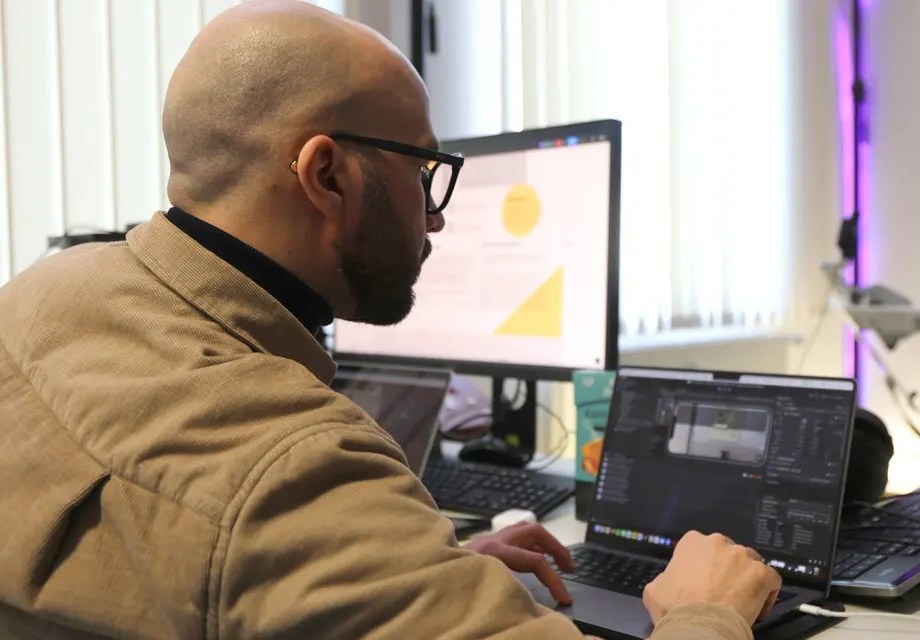
So you’re torn between an illustration course and a game design course. Maybe you feel a bit stuck: both sound insanely creative, both let you make art, so what really is the difference between illustration and game design?
This blog will help you get straight to the heart of the illustration vs. game design debate and figure out which one’s right for you.

What is Illustration?
But despite what it might seem, illustration isn't just about being able to draw. It's about visual storytelling, conceptual thinking and developing a personal style that's recognisable as yours. Whether you're working traditionally with ink and paint or digitally with a tablet, you're creating artwork that communicates something specific to an audience.
Illustrators work across children's books, magazines, advertising, animation, fashion, and packaging (basically anywhere that needs custom visual content). And while you might have images of artists hunched over sketchbooks, modern illustration embraces everything from 3D modelling to motion graphics.

What is Game Design?
A game designer is the architect behind why jumping feels satisfying, why that puzzle made you feel clever when you solved it, or why you stayed up until 3 AM trying to beat that level. You're working with game mechanics, level design, player psychology, narrative structure and balancing difficulty curves.
The interesting thing is that game designers don't necessarily need to be artists. While visual literacy helps, your main tools are logic, systems thinking and understanding what makes gameplay tick. You'll work closely with programmers, artists, sound designers and writers to bring your vision to life, but your job is designing the interactive experience itself.
Key Differences Between Illustration and Game Design
Here are where they diverge (and overlap):
| Aspect | Illustration | Game Design |
| Focus | Visual communication: form, style, narrative through static or sequential imagery | Interaction, experience, rules, player/user journey; visual plus mechanics plus feedback loops |
| Medium | Prints, editorials, books, apps, static/digital art, storyboards | Digital games, mobile, console, VR/AR, also prototyping, UI/UX, maybe live games or eSports arenas |
| Technical demands | Strong drawing, painting, composition; digital illustration tools; developing a style; less emphasis on coding or complex engineering | Tool usage (game engines like Unity/Unreal), possibly some programming; understanding UX, level/interaction design, maybe AI, logic, storytelling in interactive form |
| Creative control vs systems thinking | You’re often creating single pieces, visual narratives, images; creative expression tends to dominate | You have to think about systems: how pieces interact; how the player behaves; how to balance fun, difficulty, engagement; more collaboration across disciplines |
| Output / deliverables | Portfolios of images, series, animations/storyboards, client work | Prototype games, levels, maybe playable versions; projects that test mechanics, user testing; perhaps game jams |
Essential Skills for Illustration vs. Game Design
For illustration, you’ll need drawing fundamentals (anatomy, perspective, composition), colour theory, digital tools proficiency, conceptual thinking and personal style development. Communication skills matter too for interpreting briefs and presenting work to clients.
For game design, you’ll need systems thinking, understanding of player psychology, basic programming concepts, level design skills and prototyping abilities. Collaboration is essential since you’re working with diverse teams towards a shared vision.
You’ll notice that these are actually quite different skill sets! That’s your first big clue about which path suits you.
Game Design or Illustration – Which Course to Pick?
Here’s a litmus test to help you figure out where you might land:
- Do you like static images, drawing, painting, creating visual compositions, working from imagination or observation? If so, Illustration may be more satisfying.
- Do you get excited by “what if players did this?”, “How do you build a world that responds?”, “How is fun made, not just shown?” Then Game Design might suit.
- Can you spend hours refining pixels or textures, or instead do you prefer to tinker with mechanics, rules, systems, testing how something plays?
- Are you okay with coding or technical tools, or would you rather focus more purely on visual art?
- Career flexibility: in illustration there are many roles, but sometimes more freelance or project-based; game design often means team settings, maybe larger studios, more technical constraints, but also possibly more scale.
Also think about what kind of career you want, how much stable income matters, whether you prefer the creative freedom (but also the uncertainty) that comes with illustration, or the collaborative, structured side of game design.
Why Study Illustration or Game Design at UE?
Germany’s become a magnet for creative education, and UE sits right in the thick of it.
The illustration degree at UE isn’t about churning out generic portfolio pieces. You’ll develop your own visual language while learning industry-standard tools and techniques. Plus, you’re studying in a country with a rich tradition of graphic arts and design: think Bauhaus influence meeting contemporary digital practices.
The game design degree programme connects you with Germany’s growing games industry. You’ll work on real projects, build a portfolio that actually impresses studios and learn from practitioners who know what the industry needs right now.
Both programmes benefit from Germany’s practical, hands-on approach to education. Less abstract theory, more making things that work. And studying in English means you’ll build international networks while developing skills that travel.
Illustration vs Game Design: Future Trends
What’s coming down the road that might affect your choice?
- Increased digitisation and interactivity: Mixed reality, AR/VR and interactive storytelling will blur lines between illustration and game design. If you start in illustration, you may get asked to work on interactive visuals; game design will likely demand increasingly strong visual storytelling.
- Cross-disciplinary demand: Clients and studios increasingly expect designers who can straddle areas: good visuals and understanding of user interaction or interactivity.
- Tools becoming more accessible: Game engines, animation tools, digital illustration software are evolving fast. So learning tools matters, but what matters even more is how fast you can pick up new ones.
- Freelancing / gig economy + content creator routes: Many illustrators build careers via social media, self-publishing, however stable game design roles tend to be in studios or tech/design companies (though the indie game scene is strong and can be freelance-based).
Illustration vs Game Design: Careers, Job Roles and Salaries
Here’s how things often pan out in real life, in Germany, so you can weigh what you’d likely earn, what roles you might get.
Illustration Career Paths & Salaries
- Starting salary as an employed illustrator (permanent) in Germany: €2,000-€2,300 per month gross.
- With experience, moving into mid-level roles or more lucrative sectors (advertising, games, film) can push that to €2,700-€3,000/month or more.
- Freelance rates vary a lot: hourly rates might run from €30-€150, depending on sector, complexity, reputation.
- Roles you might find: editorial illustrator, concept artist (books, games, film), storyboard artist, animation / motion graphics work, advertising art, visual consultancy.
Game Design Career Paths & Salaries
- For game design graduates, starting salaries in Germany with a bachelor’s degree are around €3,000 gross/month, depending on role (producer, system designer etc.). Vocational training routes might offer less.
- Average annual salary in Germany for Game Designers is €45,000-€50,000/year, with variability: lower in small indie studios, higher in big tech/game studios in Berlin or Munich.
- With experience, senior roles or specialised skills (e.g. UX, AI, VR/AR) you can go significantly higher.
Conclusion
The truth is, there’s no wrong choice between an illustration course and a game design course – only the wrong choice for you.
If you want to create visual worlds on your terms, develop a signature style and see your artwork living across different media, then a BA in Illustration is calling. If you want to design interactive experiences, solve systemic problems and collaborate with diverse teams to create something players remember, then maybe a BA in Game Design is your path.
Both fields need talented people. Both offer genuine career in game design or illustration opportunities. And both will challenge you to think differently about creativity.
So don’t overthink it. Which one made your brain light up while reading this? That’s probably your answer.
